Dalmatian (dog)
The Dalmatian is a breed of dog,[2] which has a white coat marked with black or brown-coloured spots. Originating as a hunting dog,[3] it was also used as a carriage dog in its early days. The origins of this breed can be traced back to present-day Croatia and its historical region of Dalmatia.[4] It is thought that early ancestors of the breed were certain breeds of pointers and a spotted Great Dane.[5] Today, it is a popular pet and many enthusiasts enter Dalmatians into kennel club competitions.
| Dalmatian | ||||||||||||||||||||
|---|---|---|---|---|---|---|---|---|---|---|---|---|---|---|---|---|---|---|---|---|
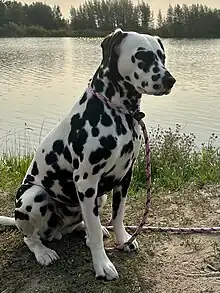 | ||||||||||||||||||||
| Other names | Carriage Dog Spotted Coach Dog Leopard Carriage Dog Firehouse Dog Plum Pudding Dog | |||||||||||||||||||
| Origin | Croatia | |||||||||||||||||||
| ||||||||||||||||||||
| ||||||||||||||||||||
| Dog (domestic dog) | ||||||||||||||||||||
Characteristics

Body
The Dalmatian is a muscular dog with excellent endurance and stamina.[2] When fully grown, according to the American Kennel Club (AKC) breed standard, it stands from 19 to 23 inches (48 to 58 cm) tall.[6]
Coat
Dalmatian puppies are born with plain white coats and their first spots usually appear within 10 days; however, spots may be visible on their skin from birth. They continue to develop until the dog is around 18 months old. Spots usually range in size from 2 to 6 cm (1.25 to 2.5 in), and are most commonly black or liver (brown) on a white background. Liver is the recessive colour in dalmatians, meaning that both parents have to carry the liver gene to produce this colour of pups. If both parents are liver, then all puppies will be liver-spotted. Black spotted dogs always have black noses, and liver spotted dogs always have brown noses.
Other colors that occur occasionally include blue (a blue-greyish colour), brindle, mosaic, orange or lemon (dark to pale yellow), or tricolored (with black, brown and orange or lemon spots). Orange and lemon occur the most frequently, especially in America, and are dilutes of the standard colours. They are defined as orange or lemon depending on their nose colour.
Another coloration pattern is a larger solid patch of color, which appears anywhere on the body, but most often on the head, ears, or tail. Patches are visible at birth and are not a group of connected spots; they are identifiable by the smooth edge of the patch, and they have no interlacing white hairs in them.[7] Pure white individuals without spots also occur occasionally.
The Dalmatian coat is usually short, fine, and dense; however, smooth-coated Dalmatians occasionally produce long-coated offspring. Long-coated Dalmatians are not acceptable in the breed standard, but these individuals experience much less shedding than their smooth-coated counterparts, which shed considerably year-round. The standard variety's short, stiff hairs often weave into carpet, clothing, upholstery, and nearly any other kind of fabric and can be difficult to remove. Weekly grooming with a hound mitt or currycomb can lessen the amount of hair Dalmatians shed, although nothing can completely prevent shedding. Due to the minimal amount of oil in their coats, Dalmatians lack a dog odor and stay fairly clean relative to many other dog breeds.[8][9]
Low uric acid (LUA) Dalmatians typically have smaller spots, which do not have as strong a pigment as standard Dalmatians. LUA breeders are trying to deal with this aspect, but it still remains possible to be able to pick a LUA out in a line up.
Litter size
Dalmatians usually have litters of six to nine pups.[10]
 Newborn Dalmatian puppies
Newborn Dalmatian puppies Dalmatian puppies, three weeks old, spots beginning to develop
Dalmatian puppies, three weeks old, spots beginning to develop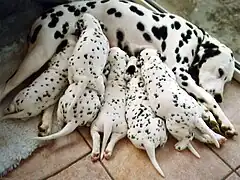 Puppies, four-five weeks old
Puppies, four-five weeks old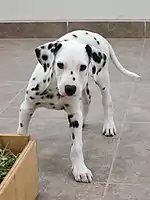 A three-month-old Dalmatian
A three-month-old Dalmatian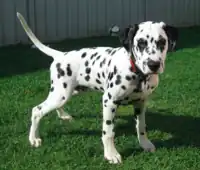 A four-month-old Dalmatian
A four-month-old Dalmatian
Health
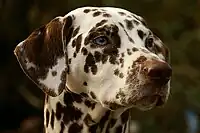
Like other breeds, Dalmatians display a propensity towards certain health problems specific to their breed, such as deafness, allergies, and urinary stones. Reputable breeders have their puppies' BAER (brainstem auditory evoked response) tested to ensure the status of the hearing on their pups. The Dalmatian Club of America lists the average lifespan of a Dalmatian at between 11 and 13 years, although some can live as long as 15 to 16 years.[11] Breed health surveys in the US and the UK show an average lifespan of 9.9 and 11.55 years, respectively.[12][13] In their late teens, both males and females may suffer bone spurs and arthritic conditions. Autoimmune thyroiditis may be a relatively common condition for the breed, affecting 11.6% of dogs.[14]
Deafness
A genetic predisposition for deafness is a serious health problem for Dalmatians; American Dalmatians exhibit a prevalence for bilateral congenital sensoneural deafness of 8% (for which there is no possible treatment), compared with 5.3% for the UK population. Deafness was not recognized by early breeders, so the breed was thought to be unintelligent. Many breeders, when hearing testing started to become the norm, were amazed to discover that they had unilateral hearing dogs. Even after recognizing the problem as a genetic fault, breeders did not understand the dogs' nature, and deafness in Dalmatians continues to be a frequent problem.
Researchers now know deafness in albino and piebald animals is caused by the absence of mature melanocytes in the inner ear.[15] This may affect one or both ears. The condition is also common in other canine breeds that share a genetic propensity for light pigmentation. This includes, but is not limited to Bull Terriers, Dogo Argentinos, Poodles, Boxers, Border Collies and Great Danes.
Typically, only dogs with bilateral hearing are bred, although those with unilateral hearing, and even dogs with bilateral deafness, make fine pets with appropriate training.[8] The main, and most noticeable, difference in a dog with uni hearing is that they do not have directional hearing; though the dog will be able to hear someone, they will not be able to hear the direction they are in. The Dalmatian Club of America's position on deaf pups is that they should not be used for breeding, and that humane euthanasia may be considered as an "alternative to placement". The British Dalmatian Club recommends only purchasing pups who are BAER-tested, and requests all members to provide BAER testing results of their puppies so that the true deafness statistics can be looked at.
It has been proved that it is the inheritance of the extreme piebald gene that causes blue eyes. It is therefore frowned upon to breed from blue-eyed Dalmatians even if they are fully hearing. Blue-eyed Dalmatians are not typically shown in the UK.
Hip dysplasia
Even though there is no evidence nor statistically relevant data[16] to suggest that hip dysplasia is another disease that affects Dalmatians, some blogs say that it affects nearly 5% of purebred Dalmatians,[17] causing those to experience limping, fatigue, moderate to severe pain, and trouble standing up. Even though this data is not available, it is believed that Dalmatians who eventually develop hip dysplasia are born with normal hips, but the soft tissues surrounding the joint grow abnormally due to their genetic makeup. The disease may affect both hips or the right or left hip, leading afflicted dogs to walk or run with an altered gait.[18] The most cited scientific report about canine hip dysplasia omits Dalmatians among the breeds usually affected by that disease.[19]
Hyperuricemia
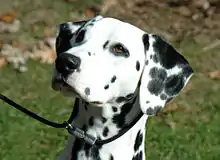
Dalmatians, like humans, can suffer from hyperuricemia.[20] Dalmatians' livers have trouble breaking down uric acid, which can build up in the blood serum (hyperuricemia) causing gout. Uric acid can also be excreted in high concentration into the urine, causing kidney stones and bladder stones. These conditions are most likely to occur in middle-aged males. Males over ten are prone to kidney stones and should have their calcium intake reduced or be given preventive medication.[21] To reduce the risk of gout and stones, owners should carefully limit the intake of purines by avoiding giving their dogs food containing organ meats, animal byproducts, or other high-purine ingredients. Hyperuricemia in Dalmatians responds to treatment with orgotein, the veterinary formulation of the antioxidant enzyme superoxide dismutase.[22]
Dalmatian-Pointer Backcross Project
Hyperuricemia in Dalmatians (as in all breeds) is inherited, but unlike other breeds, the normal gene for a uric acid transporter that allows for uric acid to enter liver cells and be subsequently broken down is not present in the breed's gene pool. Therefore, there is no possibility of eliminating hyperuricemia among pure-bred Dalmatians. The only possible solution to this problem must then be crossing Dalmatians with other breeds to reintroduce the normal uric acid transporter gene. This led to the foundation of the Dalmatian-Pointer Backcross Project, which aims to reintroduce the normal uric acid transporter gene into the Dalmatian breed. The backcross used a single English Pointer; subsequent breedings have all been to purebred Dalmatians. This project was started in 1973 by Dr. Robert Schaible. The first cross (F1) hybrids did not resemble Dalmatians very closely. The F1s were then crossed back to purebreds. This breeding produced puppies of closer resemblance to the pure Dalmatian. By the fifth generation in 1981, they resembled purebreds so much, Dr. Schaible convinced the AKC to allow two of the hybrids to be registered as purebreds. Then AKC President William F. Stifel stated, "If there is a logical, scientific way to correct genetic health problems associated with certain breed traits and still preserve the integrity of the breed standard, it is incumbent upon the American Kennel Club to lead the way."[23] The Dalmatian Club of America's (DCA) board of directors supported this decision; however, it quickly became highly controversial among the club members. A vote by DCA members opposed the registration of the hybrids, causing the AKC to ban registration to any of the dog's offspring.[24][25]
At the annual general meeting of the DCA in May 2006, the backcross issue was discussed again by club members. In June of the same year, DCA members were presented with an opportunity to vote on whether to reopen the discussion of the Dalmatian Backcross Project. The results of this ballot were nearly 2:1 in favor of re-examining support of the project by the DCA. This has begun with the publication of articles presenting more information both in support of and questioning the need for this project. In July 2011, the AKC agreed to allow registration of backcrossed Dalmatians.[26]
In 2010, the UK Kennel Club registered a backcrossed Dalmatian called Ch. Fiacre's First and Foremost. Several restrictions were imposed on the dog. Although the dog is at least 13 generations removed from the original Pointer cross, its F1 to F3 progeny will be marked on registration certificates with asterisks (which "indicate impure or unverified breeding",[27]) no progeny will be eligible to be exported as pedigrees for the next five years, and all have to be health tested.[28] UK Dalmatian breed clubs have objected to the decision by the Kennel Club. .[29]
There are still a lot of people who are against the project, due to the fact that they are not pure Dalmatians. Until you are unable to distinguish between a LUA and a HUA this is likely to remain the case. The differences between the two is very obvious to the naked eye, to the extent you can tell instantly. LUA Dalmatians have smaller spotting and very weak pigment. They are also softer to the touch and move higher on their toes like a pointer does. Many Dalmatian exhibitors feel there should have been a separate breed set up for them, so they aren’t competing against true Dalmatians.
Although LUA Dalmatians will not develop the urinary stones, they can still develop other types.
The Dalmatian Heritage Project
The Dalmatian Heritage Project began in 2005. The goal of the project is to preserve and improve the Dalmatian breed by breeding parent dogs with the following traits:
- Normal urinary metabolism
- Bilateral hearing
- Friendly and confident
All puppies in the Heritage Project are descendants of Dr. Robert Schaible's parent line. Today, "Dr. Schaible's line produces the only Dalmatians in the world today that are free of a metabolic defect that can lead to urinary tract problems."[30]
History
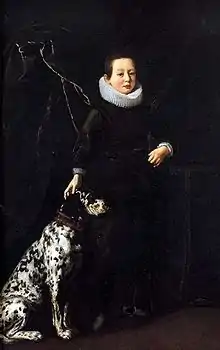
The FCI recognized Croatia as its country of origin, citing several historical sources.[31][32]
The first known written reference to a Dalmatian dog is from 1375, when Peter, Bishop of Đakovo, mentions a hunting dog principally found in Dalmatia, with short white hair and black round spots on various parts of the body, naming the breed Canis Dalmaticus.[33] The earliest illustrations of the breed have been found in Croatia: an altar painting in Veli Lošinj dating to 1600–1630, and a fresco in Zaostrog.[31] The first definitive documented descriptions of the Dalmatian (Croatian: Dalmatinski pas, Dalmatiner, Dalmatinac) trace back to the early 18th century and the archives of the Archdiocese of Đakovo, where the dog was mentioned and described as Canis Dalmaticus in the church chronicles from 1719 by Bishop Petar Bakić and then again by church chronicles of Andreas Keczkeméty in 1739.[34] In 1771, Thomas Pennant described the breed in his book Synopsis of Quadrupeds, writing that the origin of the breed is from Dalmatia; he referred to it as Dalmatian.[34] The book by Thomas Bewick, A General History of Quadrupeds, published in 1790 refers to the breed as Dalmatian or Coach Dog.[34]
During the Regency period, the Dalmatian became a status symbol and those with decorative spotting were highly prized. The breed was also used to guard the stables at night.[35]
The breed had been developed and cultivated chiefly in England.[34] The first unofficial standard for the breed was introduced by Englishman Vero Shaw in 1882.[34] In 1890 with the formation of the first Dalmatian Club in England, the standard became official.[34] When the dog with the distinctive markings was first shown in England in 1862, it was said to have been used as a guard dog and companion to the nomads of Dalmatia. The breed's unique coat became popular and widely distributed over the continent of Europe beginning in 1920. Its unusual markings were often mentioned by the old writers on cynology.[36]
Duties
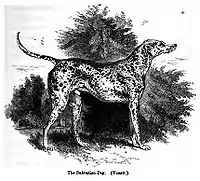
The roles of this breed are as varied as their reputed ancestors. They were used as hunting dogs, dogs of war, guarding the borders of Dalmatia.[33] To this day, the breed retains a high guarding instinct; although friendly and loyal to those the dog knows and trusts, it is often aloof with strangers and unknown dogs. Dalmatians have a strong hunting instinct and are an excellent exterminator of rats and vermin. In sporting, they have been used as bird dogs, trail hounds, retrievers, or in packs for wild boar or stag hunting. Their dramatic markings and intelligence have made them successful circus dogs throughout the years.
Dalmatians are perhaps best known for working for firefighters for their role as firefighting apparatus escorts and firehouse mascots. Since Dalmatians and horses are very compatible, the dogs were easily trained to run in front of the carriages to help clear a path and quickly guide the horses and firefighters to the fires.[37]
Dalmatians are often considered to make good watchdogs, and they may have been useful to fire brigades as guard dogs to protect a firehouse and its equipment. Fire engines used to be drawn by fast and powerful horses, a tempting target for thieves, so Dalmatians were kept in the firehouse as deterrence to theft.[37]
In popular culture
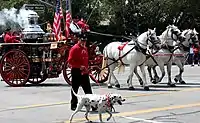
Firefighting
Dalmatians are associated with firefighting, particularly in the United States. In the days of horse-drawn fire engines, dogs would guard the horses, who could easily become uncomfortable at the scene of a fire.[38] Dalmatians were a popular breed for this job, due to their natural affinity to horses and history of being used as carriage dogs.[37] This role became unnecessary once horse-drawn fire engines were replaced with steam- and diesel-powered ones. Due to its history, the Dalmatian often serves as a mascot for the fire service, and is still chosen by many firefighters as a pet.[39]
Anheuser-Busch

The Dalmatian is also associated, particularly in the United States, with Budweiser beer and the Busch Gardens theme parks, since the Anheuser-Busch company's iconic beer wagon, drawn by a team of Clydesdale horses, is always accompanied by a Dalmatian. The company maintains several teams at various locations, which tour extensively. Dalmatians were historically used by brewers to guard the wagon while the driver was making deliveries.[40]
101 Dalmatians
The Dalmatian breed experienced a massive surge in popularity as a result of the 1956 novel The Hundred and One Dalmatians written by British author Dodie Smith, and later due to the two Walt Disney films based on the book. The Disney animated film,[41] released in 1961, later spawned a 1996 live-action remake, 101 Dalmatians. In the years following the release of the sequel 102 Dalmatians in 2000, the breed suffered greatly at the hands of irresponsible breeders and inexperienced owners. Many well-meaning enthusiasts purchased Dalmatians—often for their children—without educating themselves on the breed and the responsibilities that come with owning such a high-energy dog breed.[42] Dalmatians were abandoned in large numbers by their original owners and left with animal shelters. As a result, Dalmatian rescue organizations sprang up to care for the unwanted dogs and find them new homes. AKC registrations of Dalmatians decreased 90% during the 2000–2010 period.[43]
Lou Dog
One famous Dalmatian in popular culture is Louie or "Lou Dog", the mascot of rock band Sublime. Adopted by singer Bradley Nowell in 1990 as a puppy, Lou Dog would become a central part of Sublime's image, often wandering the stage while the band was playing as well as appearing in the band's music videos. In addition, Nowell would frequently reference Louie in song lyrics, one example being in the band's most popular song “What I Got” ("...livin' with Louie Dog's the only way to stay sane".)
After Nowell's death, Lou Dog was cared for by the band's manager until Lou's death in 2001.[44]
References
- "Dalmatian breed standard". The Kennel Club. Archived from the original on 19 January 2015. Retrieved 19 January 2015.
- "Dalmatian (dog)". thekennelclub.org.uk.
- Milivoje Urošević; (2018) Basic morphometric parameters of the Dalmatian dog (Canis dalmaticus) p. 187; {Međunarodne kinološke federacije (FCI, 2017.) koja ovu pasminu svrstava u šestu grupu, grupu goniča..International Kennel Federation (FCI, 2017) classifies this breed in the sixth group, the group of hunting dogs.}
- "Dalmatian | Characteristics, Temperament, & Facts | Britannica". www.britannica.com. 24 May 2023. Retrieved 24 June 2023.
- Dalmatian PetMD |access-date=2020-07-03
- "American Kennel Club – Dalmatian". Akc.org. Retrieved 26 October 2011.
- "Breed Faults".
- Thornton, Kim Campbell. "THE DALMATIAN". Dog World 89.11 (2004): 24.
- "American Kennel Club – Dalmatian". Akc.org. Retrieved 26 October 2011.
- "The Dalmatian Club of America Health Survey Results: General Dog Information". The Dalmatian Club of America. Retrieved 25 July 2012.
- "The Red Book: The Dalmatian Club of America's Informational brochure regarding Dalmatians". The Dalmatian Club of America. Retrieved 20 April 2011.
- "The Dalmatian Club of America Health Survey Results: Health Related Conditions". The Dalmatian Club of America. Retrieved 20 April 2011.
- Summary results for the purebred dog health survey for Dalmatians (PDF), The Kennel Club, archived (PDF) from the original on 23 April 2015, retrieved 19 September 2014
- "OFA: Thyroid Statistics". Archived from the original on 30 May 2013. Retrieved 27 July 2013.
- Proctor PH (1988). "Free Radicals and Human Disease". In Weber HH, Miquel J, Quintanilha AT (eds.). Handbook of free radicals and antioxidants in biomedicine. Vol. 1. Boca Raton: CRC Press. pp. 209–21. ISBN 978-0-8493-3268-5.
- Vasiliadis, Danae; Metzger, Julia; Distl, Ottmar (December 2020). "Demographic assessment of the Dalmatian dog – effective population size, linkage disequilibrium, and inbreeding coefficients". Canine Medicine and Genetics. 7 (1): 3. doi:10.1186/s40575-020-00082-y. PMC 7371805. PMID 32835229.
- "Common Dalmatian Health Problems". Archived from the original on 4 February 2015. Retrieved 20 January 2018.
- "Hip Dysplasia in Dalmatians – Dog'sHealth.com Blog". Dogshealth.com. Retrieved 2 December 2017.
- Martin, S. W.; Kirby, K.; Pennock, P. W. (November 1980). "Canine Hip Dysplasia: Breed Effects". The Canadian Veterinary Journal. 21 (11): 293–296. PMC 1789813. PMID 7459792.
- Friedman, Meyer; Byers, Sanford O. (September 1948). "Observations concerning the causes of the excess excretion of uric acid in the dalmatian dog". Journal of Biological Chemistry. 175 (2): 727–735. doi:10.1016/S0021-9258(18)57191-X. PMID 18880769.
- Simkin PA (August 2005). "The Dalmatian defect: a hepatic endocrinopathy of urate transport". Arthritis Rheum. 52 (8): 2257–62. doi:10.1002/art.21241. PMID 16052594.
- Lowrey JC (March 1976). "An unusual diet-derived inflammatory dermatosis in a Dalmatian dog responds to orgotein". Vet Med Small Anim Clin. 71 (3): 289–95. PMID 1045695.
- Schaible, Robert H. (April 1981). "A Dalmatian Study: The Genetic Correction of Health Problems". The AKC Gazette. Archived from the original on 11 March 2013. Retrieved 13 January 2010.
- Jensen, Mary–Lynn: Dalmatian Backcross Project. Past, Present and Future. In: Spotter, Fall 2006, p. 44–46 (Journal of the Dalmatian Club of America) Online PDF 296 kB, accessed 1 September 2013.
- Schaible, Robert H.: Backcross Project: Long–Standing Issues. In: Spotter, Winter 2006, p. 34 (Journal of the Dalmatian Club of America) Online PDF 34 kB, accessed 1 September 2013.
- "AKC agrees to register low uric acid Dalmatians". Dog World. Archived from the original on 5 October 2011. Retrieved 29 July 2011.
- "Registration Rules and Regulations (B Regs)". The Kennel Club. Retrieved 12 January 2010.
- "Registration of a Low Uric Acid Dalmatian Import from the USA". The Kennel Club. 12 January 2010. Archived from the original on 25 March 2012. Retrieved 12 January 2010.
- "Backcross Dalmatians – The UK Dalmatian Clubs Respond". British Dalmatian Club. 2 February 2010. Retrieved 21 March 2011.
- "About the Project". The Dalmatian Heritage Project. Archived from the original on 6 November 2014. Retrieved 20 December 2014.
- "Fédération Cynologique Internationale Standard of Dalmatian, No. 153, dated 14 April 1999" (PDF). Fci.be. Retrieved 26 October 2011.
- "Dalmatian – FCI Standard" (PDF). Retrieved 12 August 2013.
- Roman Ozimec, Frane Strikić, Jasminka Karoglan Kontić; (2015) Tradicijske sorte i pasmine Dalmacije(Traditional varieties and breeds of Dalmatia) p 521; ISBN 978-953-7429-51-5
- "FCI-Standard N° 153 – DALMATIAN (Dalmatinski pas)" (PDF). Hks.hr. Croatian Kennel Club. 30 May 2011. Retrieved 22 May 2012.
- "The Kennel Club". thekennelclub.org.uk.
- Schneider-Leyer, Erich; Fitch Daglish, Eric. Dogs of the World, Popular Dogs, 1964.
- "Fire buffs traditions". Windsor Fire. Archived from the original on 30 July 2013. Retrieved 20 January 2013.
- "The history of Dalmatians in the fire service". 10 February 2017. Retrieved 11 September 2018.
- "Fire Dogs and Fire Horses". Publicsafety.net. Retrieved 26 October 2011.
- "British Carriage Dog Society". carriagedog.org. Archived from the original on 19 November 2014. Retrieved 1 September 2014.
- "One Hundred and One Dalmatians (1961)". 7 March 2008. Archived from the original on 7 March 2008. Retrieved 26 October 2011.
- "With Finding Nemo, Marine Conservation Group Finds Opportunity to Spotlight Safe Harvesting Practices" (PDF). 1 November 2005. Archived from the original (PDF) on 1 November 2005. Retrieved 26 October 2011.
- "The Pawesome Post – Facts and Stats". thepawesomepost.com. Retrieved 11 September 2023.
- "Lou Dog stories". Ocweekly.com. 25 May 2011. Archived from the original on 15 January 2012. Retrieved 26 January 2012.
External links
- Dalmatian (dog) at Curlie
- Deafness in Dogs: LSU & Dr. Strain
- Kluth, Susanne; Distl, Ottmar (4 December 2013). "Congenital Sensorineural Deafness in Dalmatian Dogs Associated with Quantitative Trait Loci". PLOS ONE. 8 (12): e80642. Bibcode:2013PLoSO...880642K. doi:10.1371/journal.pone.0080642. PMC 3851758. PMID 24324618.
- Dalmatian-Pointer Backcross information translated to multiple languages
- About of Lemon Dalmatians
- A Guide To The Different Types Of Dalmatian Colors